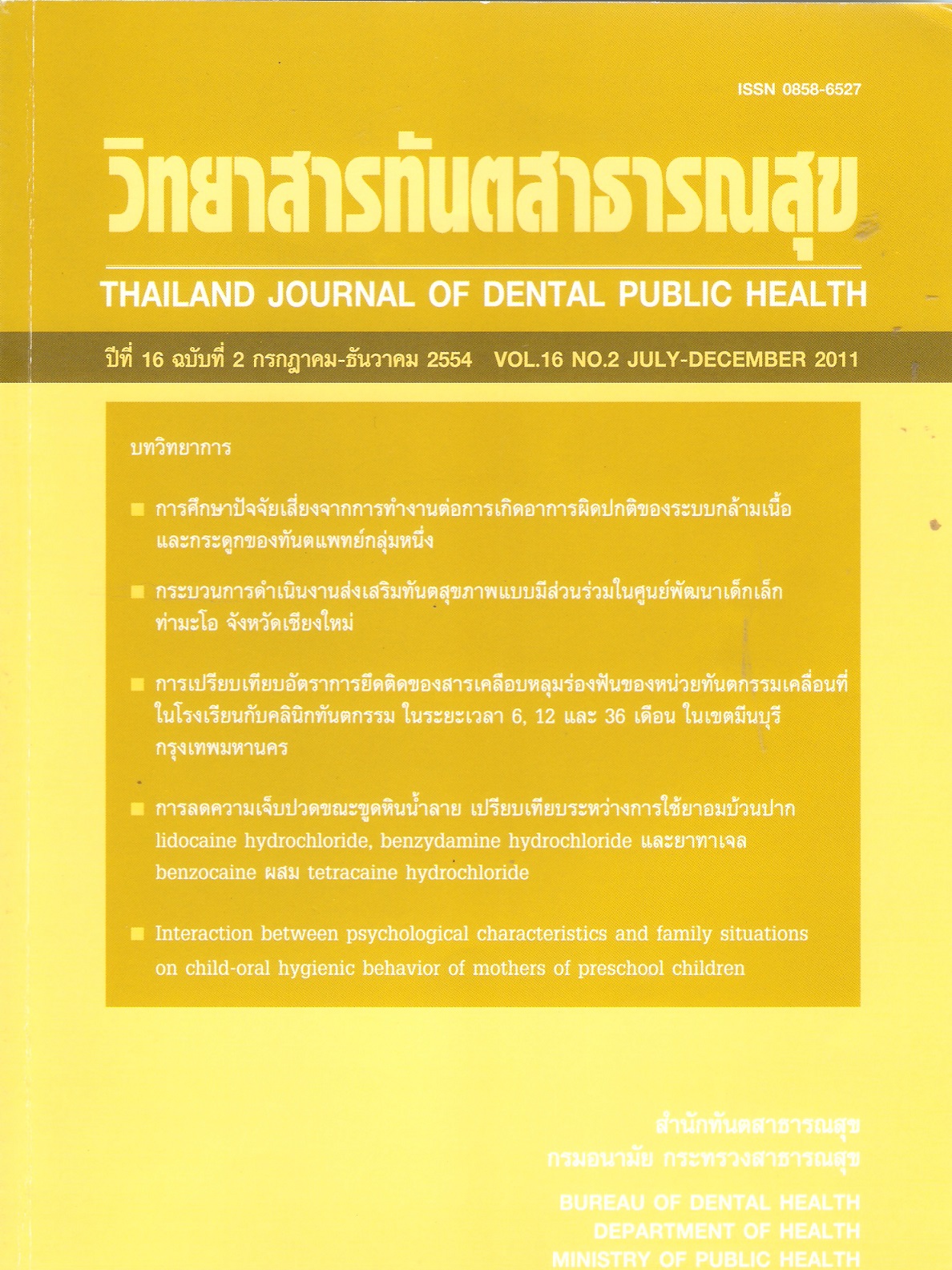A study of occupational risk factors which related to musculosketetal disorders for dentist
Main Article Content
Abstract
The objective of this study was to confirm the occupational risk factors which related to musculoskeletal disorders. The cross-sectional survey research design was set up to obtain the data with the sample size of 360.A postal questionnaire survey of licensed dentists in Bangkok registered with the Thailand Dental Association was randomly. It was found that 69.7% showed at least one musculoskeletal symptom in the past 12 months. The most prevalent pain, 71.1%, occurred in shoulder, the latter 60.8, 49.7 and 46.7% affected on neck, upper back and wrist or hand respectively. The individual risk factors, gender, age, work experience, were significantly related to musculoskeletal disorder (p ≤ 0.05). The work - related risk factors, working hours, breaking time, handedness, using vibrating tool, position and posture, repetitive movement, working hour on computer and stress were significantly related to musculoskeletal disorder (p ≤ 0.05). The health behavior, frequency of exercise per week and time to do exercise were significantly related to musculoskeletal disorder (p ≤ 0.01).
Downloads
Article Details
References
2. Valachi B. and Valachi K. Mechanisms leading to musculoskeletal disorders in dentistry. American Dental Association 2003; 134:134-1350.
3. Rada RE. and Johnson-Leong C. Stress, burnout, anxiety and depression among dentists. Practice Management JADA, 2004; 135:788-794.
4. Puriene A., Aleksejuniene J., Petrauskiene J., Balciuniene I. and Janulyte V. Self-reported Occupational Health Issues among LithuanianDentists. Industrial Health 2008;46:369-374.
5. Alexopoulos EC., Stathi IC. and Charizani F. Prevalence of musculoskeletal disorders in dentists. BMC Musculoskeletal Disorders 2004; 5:1-8.
6. Leggat PA. and Smith DR. Musculoskeletal disorders self reported by dentists in Queensland, Australia. Australian Dental Journal2006, 51(4):324-327.
7. Chowanadisai S., Kukiattrakoon B.,Yapong B., Kedjarune U. and Leggat PA. Occupational health problems of dentists in southern Thailand. Int Dent J, 2000; 50(1):36-40.
8. แมนสรวง วงศ์อภัย. ภาวะสุขภาพจากการ ทำงานของทันตแพทย์ภาครัฐ จังหวัด เชียงใหม่, การค้นคว้าแบบอิสระสาธารณสุขศาสตรมหาบัณฑิต บัณฑิตวิทยาลัย มหาวิทยาลัยเชียงใหม่, พ.ศ. 2551
9. Yamane T. 1967. Statistics: An introductory analysis. 2nd ed. New York : Harper and Row.
10. กัลยา วานิชย์บัญชา, การใช้ SPSS for Windows ในการวิเคราะห์ข้อมูล พิมพ์ ครั้งที่ 8 บริษัทธรรมสาร จำกัดกรุงเทพมหานคร, 2549. หน้า16.
11. Kuorinka I., Jonsson B., Kilbom A., Vinterberg H., Biering-Sorensen F., Andersson G. et al. Standardised Nordic questionnaires for the analysis of musculoskeletal symptoms. Appl Ergon 1987; 18(3): 233-237.
12. Yamalik N. Musculoskeletal disorders(MSDs) and dental practice Part 1. General information-terminology, aetiology, work-relatedness, magnitude of the problem, andprevention. Int Dent J 2006; 56:359-366.
13. Larsson B. Work related neckshoulder pain: a review on magnitude, risk factors, biochemical characteristics, clinical picture and preventive interventions. Best Practice & Research Clinical Rheumatology 2007; 21:447-463.
14. Barbe MF and Barr AE. Inflammation and the pathophysiology of work-related musculoskeletal disorders. Brain Behav Immun 2006; 20(5):423-429.
15. Visser JL. and Straker LM. Investigation of Discomfort Experienced by Dental Therapists and Assistants and Works. Aust Dent J 1994; 39:39-44.
16. Kihara T. Dental care works and work-related complaints of dentists.Kurume Medical Journal. 1995; 42(4):251-257
17. Green EJ. and Brown ME. An aid to the elimination of tension and fatigue: Body mechanics applied to the practice of dentistry. J Am Dent Assoc 1963; 67: 679-97
18. Reitemeier B. Psychophysiological and epidemiological investigations on the dentist. Reviews on Environmental Health 1996; 11:57-63
19. Rundcrantz BL., Johnsson B. and Moritz U. Occupational cervicobrachial disorders among dentists-analysis of ergonomics and locomotor functions. Swedish Dental Journal 1991; 15:105-115.
20. Davies MH. and Eccles JD. Attitudes of dental patients to conservation treatment in different chair positions. Journal of Dentistry 1978; 6:294.
21. Rundcrantz BL., Johnsson B. and Moritz U. Cervical pain and discomfort among dentists. Swedish Dental Journal 1990; 14:71-80.
22. NIOSH [Second Printing, 1997.] Musculoskeletal Disorders and Workplace Factors: A Critical Review of Epidemiologic Evidence for Related Musculoskeletal Disorders of the Neck, Upper Extremity, and Low Back. Cincinnati, OH: US Department of Health and Human Services, Public Health Service, Centers for Disease Control and Prevention, National Institute for Occupational Safety and Health. DHHS (NIOSH) Publication No. 97-141.
23. Kroemer KHF. Cumulative trauma disorder their recognition and ergonomics measures to avoid them. Applied ergonomics 1989; 20(4): 274-280.
24. Akesson I., Lundborg G., Horstmann V. and Skerfving S. Neuropathy in female dental personnel exposed to high frequency vibrations. Occupational and Environmental Medicine 1995; 52:116-123.
25. Ariens GA. Psychosocial risk factors for neck pain: a systematic review. American Journal of Industrial Medicine 2001; 39(2):180-193.
26. Breakwell GM. Are you stressed out? American Journal of Nursing 1990, 9: 31-33.
27. Jeffrey Nk., Benjamin CA., Barbara BC., Christine H., Anne HF. and Christopher MC. Prevalence of Upper Extremity Musculoskeletal Disorders in College Students. The American Journal of Medicine 2000; 109:586-588.
28. Auguston TE. and Morken T. Musculoskeletal problems among dental health personnel. A survey of the public dental health services in Hordaland (Norwegien). Tidsskrift for Den Norske Laegeforening 1996;116:2776-2780
29. Shugars DA., Williams D., Cline SJ. and Fishburne C. Musculoskeletal back pain among dentists. General Dentistry 1984; 32:481-48


